University Environmental Science Module: POPs Literature Review
VerifiedAdded on 2021/05/31
|7
|1899
|124
Literature Review
AI Summary
This literature review examines persistent organic pollutants (POPs), defining them as organic compounds resistant to environmental degradation, leading to bioaccumulation and adverse health and environmental effects. It traces the history of POPs, from their use in DDT to industrial chemicals, and discusses their impact on human health, including effects on the immune, reproductive, and endocrine systems. The review covers the challenges associated with POPs, such as their persistence and toxicity. It also details the regulatory measures adopted by developed and developing countries, in compliance with the Stockholm Convention, including national implementation plans and bans on specific chemicals. Furthermore, the review addresses challenges in eliminating POPs due to their chemical stability and long-range transport, emphasizing the need for ongoing monitoring and management strategies. References from various scientific publications support the findings and arguments presented in this assignment.
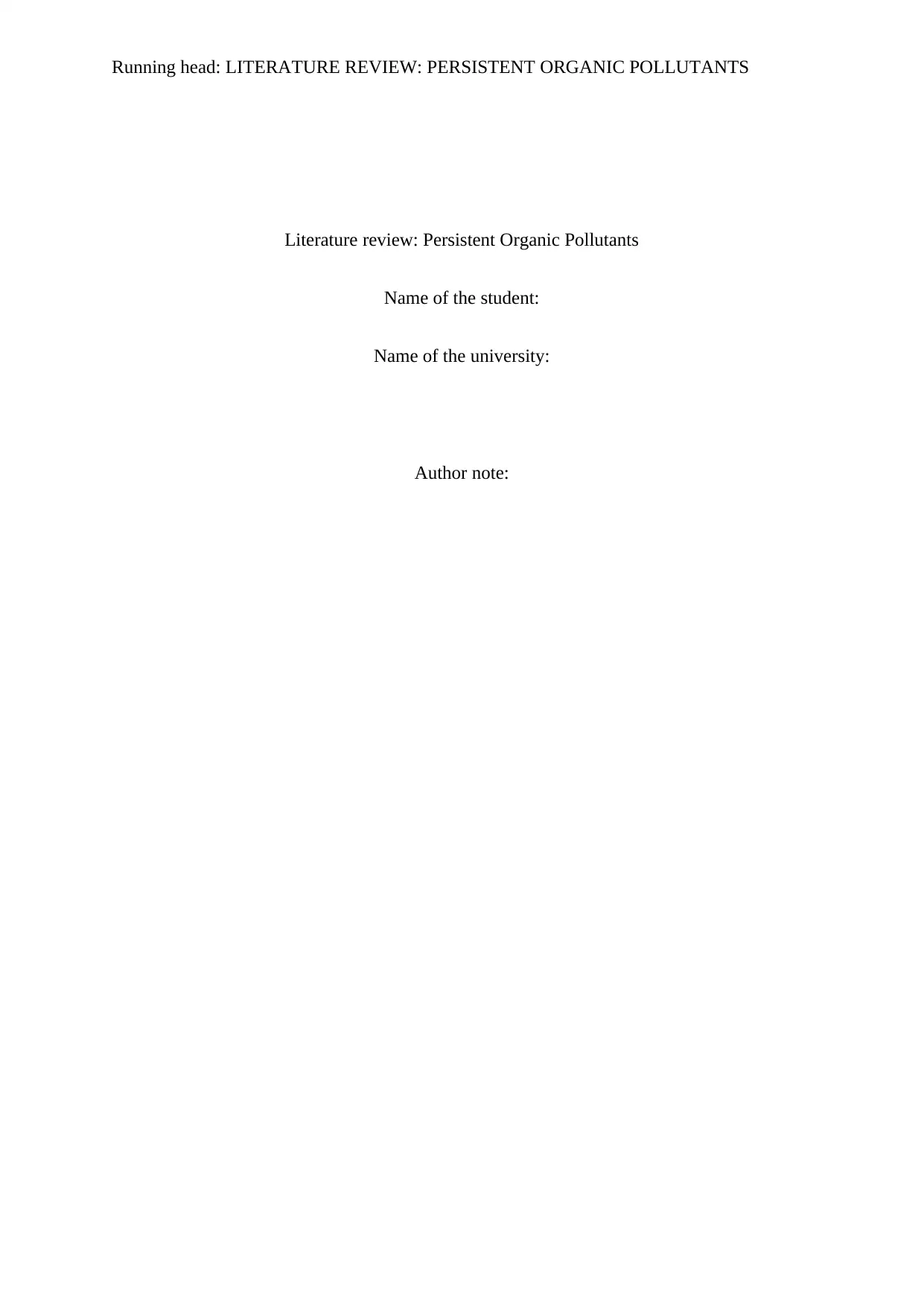
Running head: LITERATURE REVIEW: PERSISTENT ORGANIC POLLUTANTS
Literature review: Persistent Organic Pollutants
Name of the student:
Name of the university:
Author note:
Literature review: Persistent Organic Pollutants
Name of the student:
Name of the university:
Author note:
Paraphrase This Document
Need a fresh take? Get an instant paraphrase of this document with our AI Paraphraser
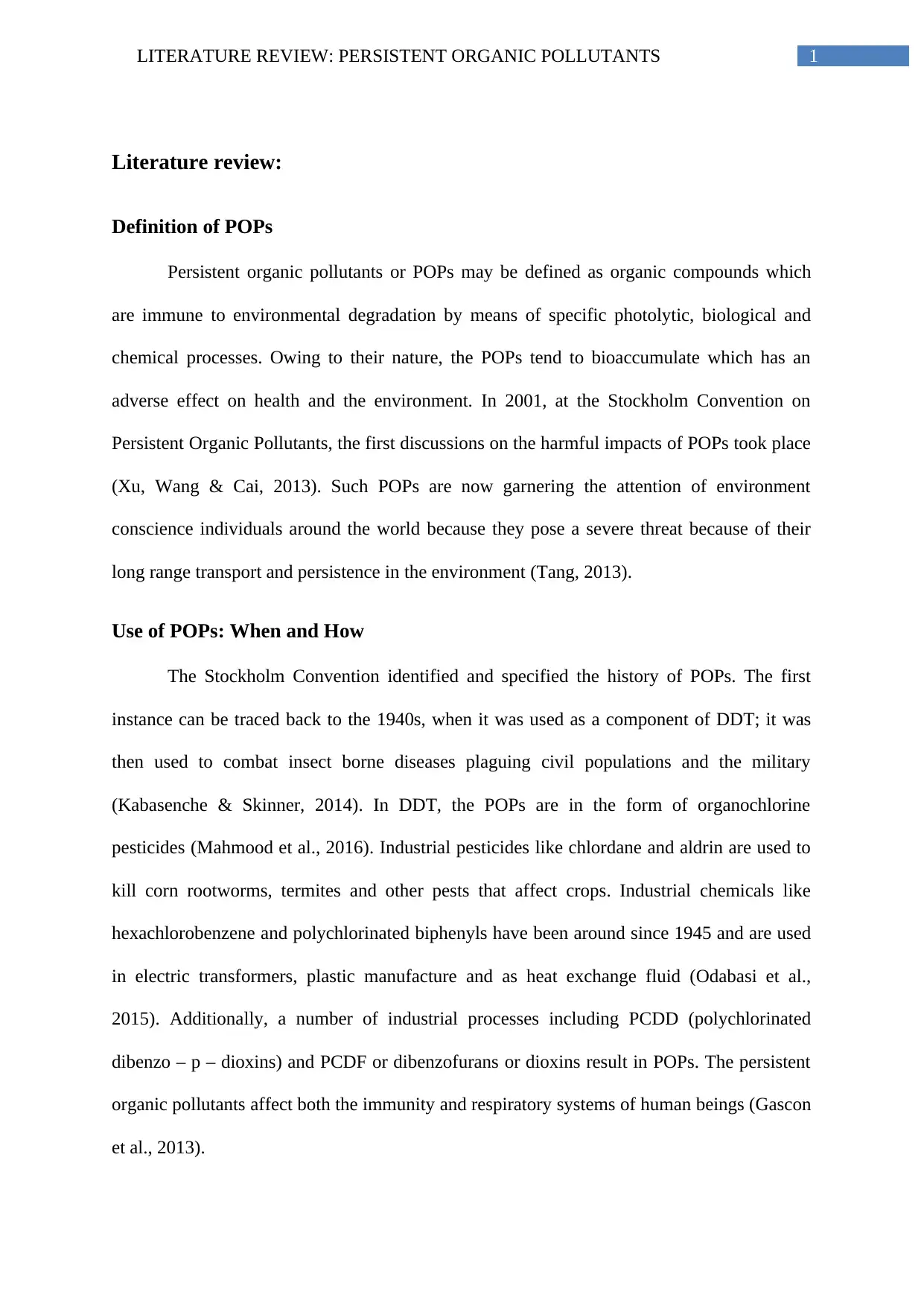
1LITERATURE REVIEW: PERSISTENT ORGANIC POLLUTANTS
Literature review:
Definition of POPs
Persistent organic pollutants or POPs may be defined as organic compounds which
are immune to environmental degradation by means of specific photolytic, biological and
chemical processes. Owing to their nature, the POPs tend to bioaccumulate which has an
adverse effect on health and the environment. In 2001, at the Stockholm Convention on
Persistent Organic Pollutants, the first discussions on the harmful impacts of POPs took place
(Xu, Wang & Cai, 2013). Such POPs are now garnering the attention of environment
conscience individuals around the world because they pose a severe threat because of their
long range transport and persistence in the environment (Tang, 2013).
Use of POPs: When and How
The Stockholm Convention identified and specified the history of POPs. The first
instance can be traced back to the 1940s, when it was used as a component of DDT; it was
then used to combat insect borne diseases plaguing civil populations and the military
(Kabasenche & Skinner, 2014). In DDT, the POPs are in the form of organochlorine
pesticides (Mahmood et al., 2016). Industrial pesticides like chlordane and aldrin are used to
kill corn rootworms, termites and other pests that affect crops. Industrial chemicals like
hexachlorobenzene and polychlorinated biphenyls have been around since 1945 and are used
in electric transformers, plastic manufacture and as heat exchange fluid (Odabasi et al.,
2015). Additionally, a number of industrial processes including PCDD (polychlorinated
dibenzo – p – dioxins) and PCDF or dibenzofurans or dioxins result in POPs. The persistent
organic pollutants affect both the immunity and respiratory systems of human beings (Gascon
et al., 2013).
Literature review:
Definition of POPs
Persistent organic pollutants or POPs may be defined as organic compounds which
are immune to environmental degradation by means of specific photolytic, biological and
chemical processes. Owing to their nature, the POPs tend to bioaccumulate which has an
adverse effect on health and the environment. In 2001, at the Stockholm Convention on
Persistent Organic Pollutants, the first discussions on the harmful impacts of POPs took place
(Xu, Wang & Cai, 2013). Such POPs are now garnering the attention of environment
conscience individuals around the world because they pose a severe threat because of their
long range transport and persistence in the environment (Tang, 2013).
Use of POPs: When and How
The Stockholm Convention identified and specified the history of POPs. The first
instance can be traced back to the 1940s, when it was used as a component of DDT; it was
then used to combat insect borne diseases plaguing civil populations and the military
(Kabasenche & Skinner, 2014). In DDT, the POPs are in the form of organochlorine
pesticides (Mahmood et al., 2016). Industrial pesticides like chlordane and aldrin are used to
kill corn rootworms, termites and other pests that affect crops. Industrial chemicals like
hexachlorobenzene and polychlorinated biphenyls have been around since 1945 and are used
in electric transformers, plastic manufacture and as heat exchange fluid (Odabasi et al.,
2015). Additionally, a number of industrial processes including PCDD (polychlorinated
dibenzo – p – dioxins) and PCDF or dibenzofurans or dioxins result in POPs. The persistent
organic pollutants affect both the immunity and respiratory systems of human beings (Gascon
et al., 2013).
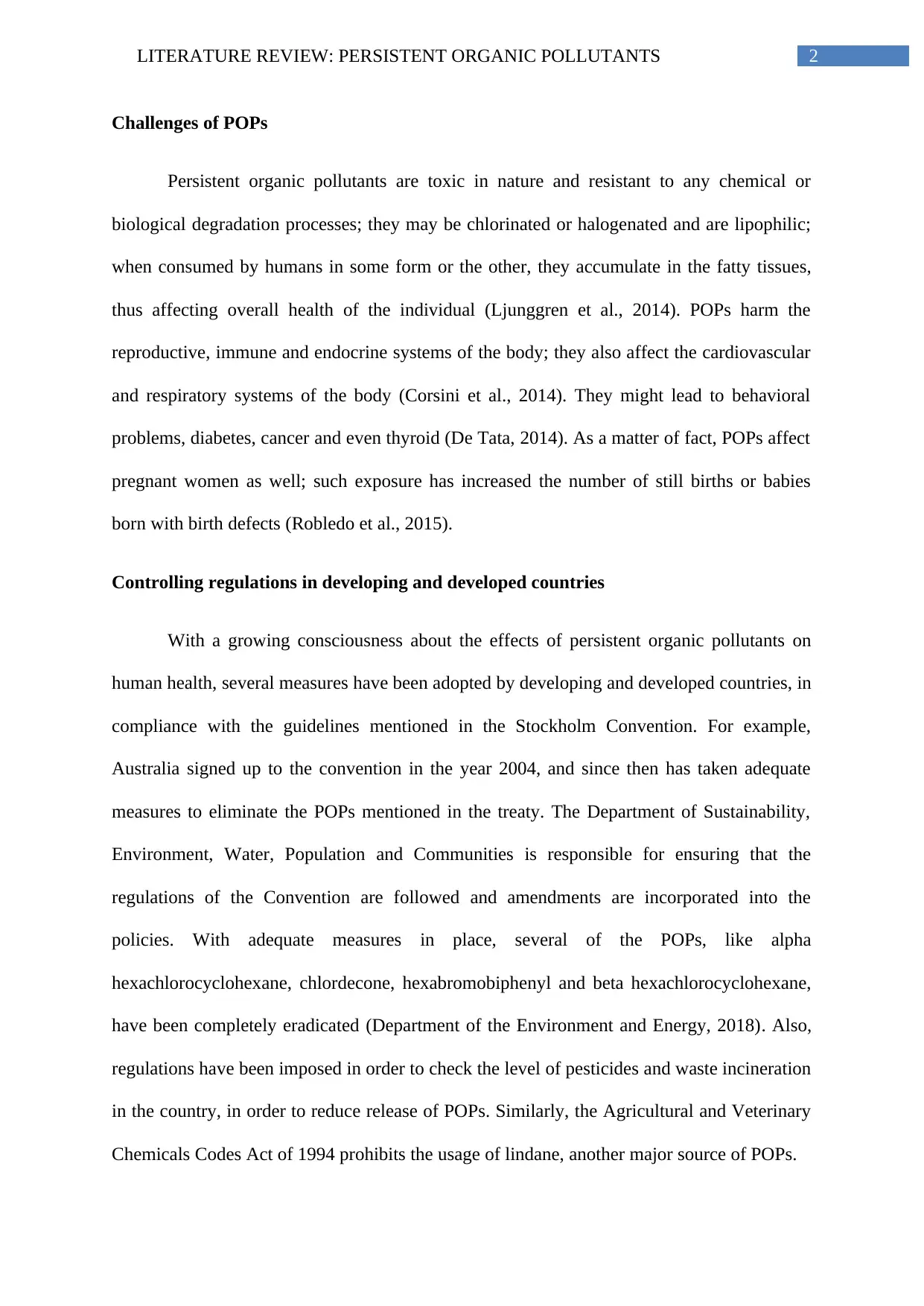
2LITERATURE REVIEW: PERSISTENT ORGANIC POLLUTANTS
Challenges of POPs
Persistent organic pollutants are toxic in nature and resistant to any chemical or
biological degradation processes; they may be chlorinated or halogenated and are lipophilic;
when consumed by humans in some form or the other, they accumulate in the fatty tissues,
thus affecting overall health of the individual (Ljunggren et al., 2014). POPs harm the
reproductive, immune and endocrine systems of the body; they also affect the cardiovascular
and respiratory systems of the body (Corsini et al., 2014). They might lead to behavioral
problems, diabetes, cancer and even thyroid (De Tata, 2014). As a matter of fact, POPs affect
pregnant women as well; such exposure has increased the number of still births or babies
born with birth defects (Robledo et al., 2015).
Controlling regulations in developing and developed countries
With a growing consciousness about the effects of persistent organic pollutants on
human health, several measures have been adopted by developing and developed countries, in
compliance with the guidelines mentioned in the Stockholm Convention. For example,
Australia signed up to the convention in the year 2004, and since then has taken adequate
measures to eliminate the POPs mentioned in the treaty. The Department of Sustainability,
Environment, Water, Population and Communities is responsible for ensuring that the
regulations of the Convention are followed and amendments are incorporated into the
policies. With adequate measures in place, several of the POPs, like alpha
hexachlorocyclohexane, chlordecone, hexabromobiphenyl and beta hexachlorocyclohexane,
have been completely eradicated (Department of the Environment and Energy, 2018). Also,
regulations have been imposed in order to check the level of pesticides and waste incineration
in the country, in order to reduce release of POPs. Similarly, the Agricultural and Veterinary
Chemicals Codes Act of 1994 prohibits the usage of lindane, another major source of POPs.
Challenges of POPs
Persistent organic pollutants are toxic in nature and resistant to any chemical or
biological degradation processes; they may be chlorinated or halogenated and are lipophilic;
when consumed by humans in some form or the other, they accumulate in the fatty tissues,
thus affecting overall health of the individual (Ljunggren et al., 2014). POPs harm the
reproductive, immune and endocrine systems of the body; they also affect the cardiovascular
and respiratory systems of the body (Corsini et al., 2014). They might lead to behavioral
problems, diabetes, cancer and even thyroid (De Tata, 2014). As a matter of fact, POPs affect
pregnant women as well; such exposure has increased the number of still births or babies
born with birth defects (Robledo et al., 2015).
Controlling regulations in developing and developed countries
With a growing consciousness about the effects of persistent organic pollutants on
human health, several measures have been adopted by developing and developed countries, in
compliance with the guidelines mentioned in the Stockholm Convention. For example,
Australia signed up to the convention in the year 2004, and since then has taken adequate
measures to eliminate the POPs mentioned in the treaty. The Department of Sustainability,
Environment, Water, Population and Communities is responsible for ensuring that the
regulations of the Convention are followed and amendments are incorporated into the
policies. With adequate measures in place, several of the POPs, like alpha
hexachlorocyclohexane, chlordecone, hexabromobiphenyl and beta hexachlorocyclohexane,
have been completely eradicated (Department of the Environment and Energy, 2018). Also,
regulations have been imposed in order to check the level of pesticides and waste incineration
in the country, in order to reduce release of POPs. Similarly, the Agricultural and Veterinary
Chemicals Codes Act of 1994 prohibits the usage of lindane, another major source of POPs.
⊘ This is a preview!⊘
Do you want full access?
Subscribe today to unlock all pages.

Trusted by 1+ million students worldwide
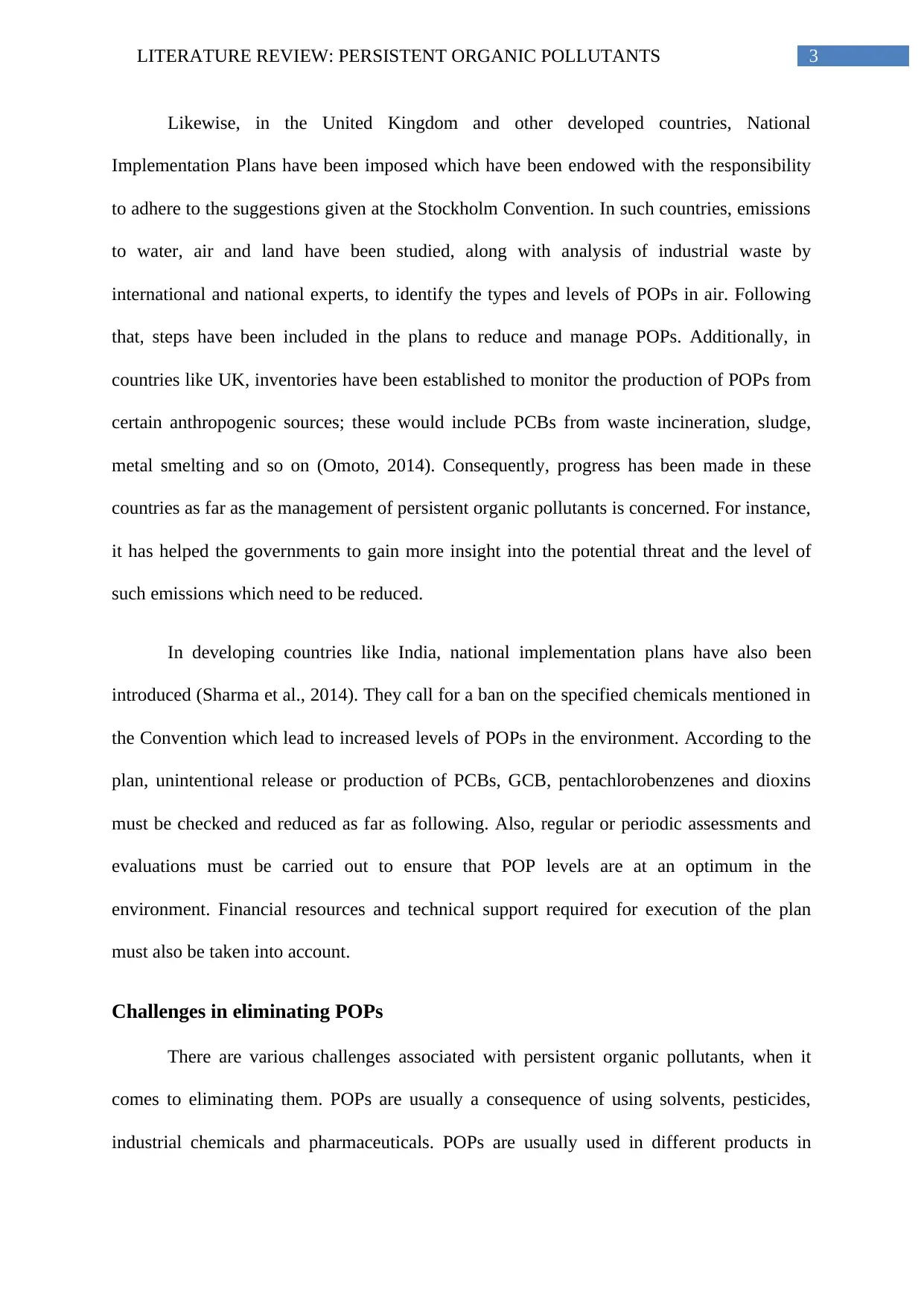
3LITERATURE REVIEW: PERSISTENT ORGANIC POLLUTANTS
Likewise, in the United Kingdom and other developed countries, National
Implementation Plans have been imposed which have been endowed with the responsibility
to adhere to the suggestions given at the Stockholm Convention. In such countries, emissions
to water, air and land have been studied, along with analysis of industrial waste by
international and national experts, to identify the types and levels of POPs in air. Following
that, steps have been included in the plans to reduce and manage POPs. Additionally, in
countries like UK, inventories have been established to monitor the production of POPs from
certain anthropogenic sources; these would include PCBs from waste incineration, sludge,
metal smelting and so on (Omoto, 2014). Consequently, progress has been made in these
countries as far as the management of persistent organic pollutants is concerned. For instance,
it has helped the governments to gain more insight into the potential threat and the level of
such emissions which need to be reduced.
In developing countries like India, national implementation plans have also been
introduced (Sharma et al., 2014). They call for a ban on the specified chemicals mentioned in
the Convention which lead to increased levels of POPs in the environment. According to the
plan, unintentional release or production of PCBs, GCB, pentachlorobenzenes and dioxins
must be checked and reduced as far as following. Also, regular or periodic assessments and
evaluations must be carried out to ensure that POP levels are at an optimum in the
environment. Financial resources and technical support required for execution of the plan
must also be taken into account.
Challenges in eliminating POPs
There are various challenges associated with persistent organic pollutants, when it
comes to eliminating them. POPs are usually a consequence of using solvents, pesticides,
industrial chemicals and pharmaceuticals. POPs are usually used in different products in
Likewise, in the United Kingdom and other developed countries, National
Implementation Plans have been imposed which have been endowed with the responsibility
to adhere to the suggestions given at the Stockholm Convention. In such countries, emissions
to water, air and land have been studied, along with analysis of industrial waste by
international and national experts, to identify the types and levels of POPs in air. Following
that, steps have been included in the plans to reduce and manage POPs. Additionally, in
countries like UK, inventories have been established to monitor the production of POPs from
certain anthropogenic sources; these would include PCBs from waste incineration, sludge,
metal smelting and so on (Omoto, 2014). Consequently, progress has been made in these
countries as far as the management of persistent organic pollutants is concerned. For instance,
it has helped the governments to gain more insight into the potential threat and the level of
such emissions which need to be reduced.
In developing countries like India, national implementation plans have also been
introduced (Sharma et al., 2014). They call for a ban on the specified chemicals mentioned in
the Convention which lead to increased levels of POPs in the environment. According to the
plan, unintentional release or production of PCBs, GCB, pentachlorobenzenes and dioxins
must be checked and reduced as far as following. Also, regular or periodic assessments and
evaluations must be carried out to ensure that POP levels are at an optimum in the
environment. Financial resources and technical support required for execution of the plan
must also be taken into account.
Challenges in eliminating POPs
There are various challenges associated with persistent organic pollutants, when it
comes to eliminating them. POPs are usually a consequence of using solvents, pesticides,
industrial chemicals and pharmaceuticals. POPs are usually used in different products in
Paraphrase This Document
Need a fresh take? Get an instant paraphrase of this document with our AI Paraphraser
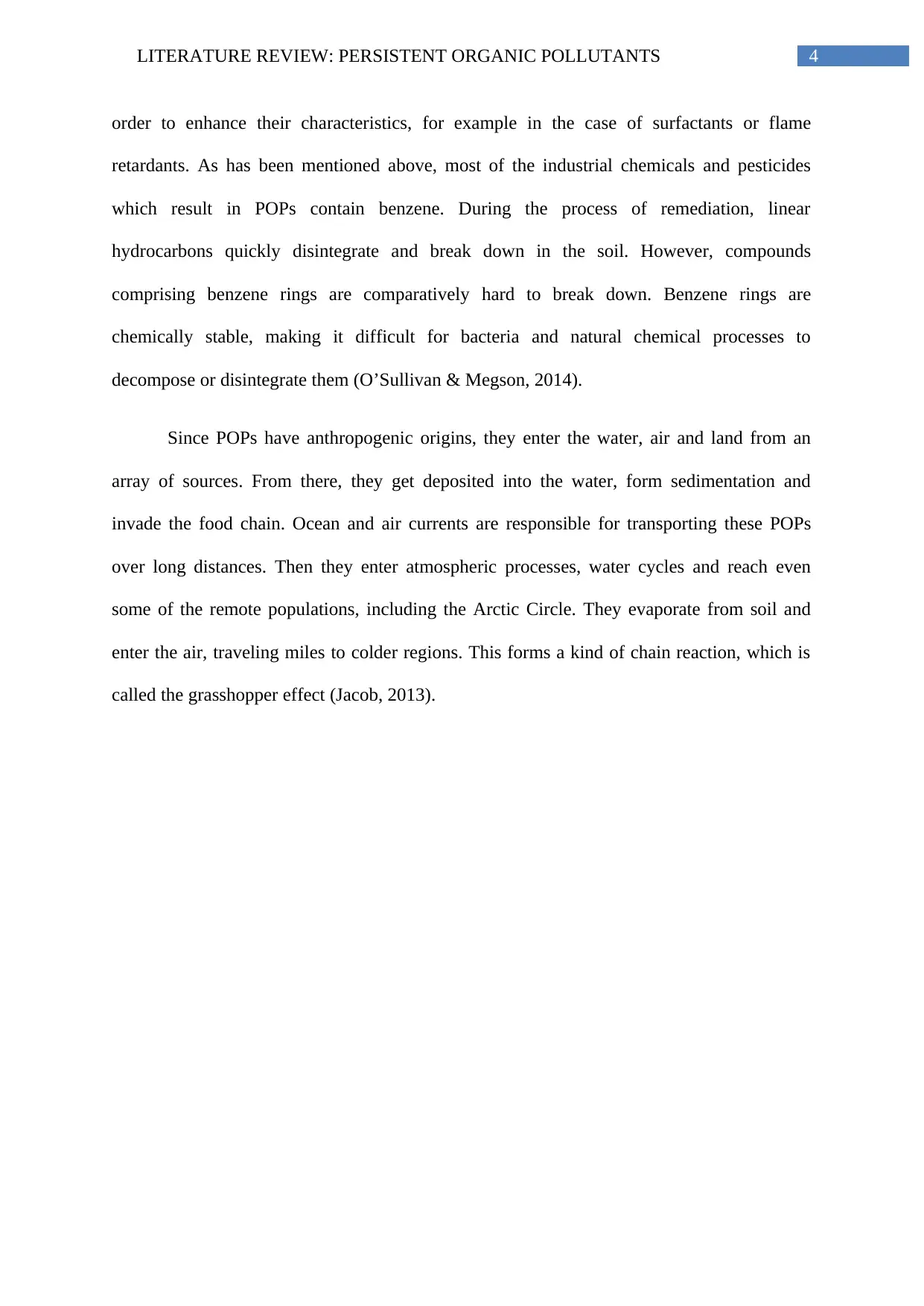
4LITERATURE REVIEW: PERSISTENT ORGANIC POLLUTANTS
order to enhance their characteristics, for example in the case of surfactants or flame
retardants. As has been mentioned above, most of the industrial chemicals and pesticides
which result in POPs contain benzene. During the process of remediation, linear
hydrocarbons quickly disintegrate and break down in the soil. However, compounds
comprising benzene rings are comparatively hard to break down. Benzene rings are
chemically stable, making it difficult for bacteria and natural chemical processes to
decompose or disintegrate them (O’Sullivan & Megson, 2014).
Since POPs have anthropogenic origins, they enter the water, air and land from an
array of sources. From there, they get deposited into the water, form sedimentation and
invade the food chain. Ocean and air currents are responsible for transporting these POPs
over long distances. Then they enter atmospheric processes, water cycles and reach even
some of the remote populations, including the Arctic Circle. They evaporate from soil and
enter the air, traveling miles to colder regions. This forms a kind of chain reaction, which is
called the grasshopper effect (Jacob, 2013).
order to enhance their characteristics, for example in the case of surfactants or flame
retardants. As has been mentioned above, most of the industrial chemicals and pesticides
which result in POPs contain benzene. During the process of remediation, linear
hydrocarbons quickly disintegrate and break down in the soil. However, compounds
comprising benzene rings are comparatively hard to break down. Benzene rings are
chemically stable, making it difficult for bacteria and natural chemical processes to
decompose or disintegrate them (O’Sullivan & Megson, 2014).
Since POPs have anthropogenic origins, they enter the water, air and land from an
array of sources. From there, they get deposited into the water, form sedimentation and
invade the food chain. Ocean and air currents are responsible for transporting these POPs
over long distances. Then they enter atmospheric processes, water cycles and reach even
some of the remote populations, including the Arctic Circle. They evaporate from soil and
enter the air, traveling miles to colder regions. This forms a kind of chain reaction, which is
called the grasshopper effect (Jacob, 2013).
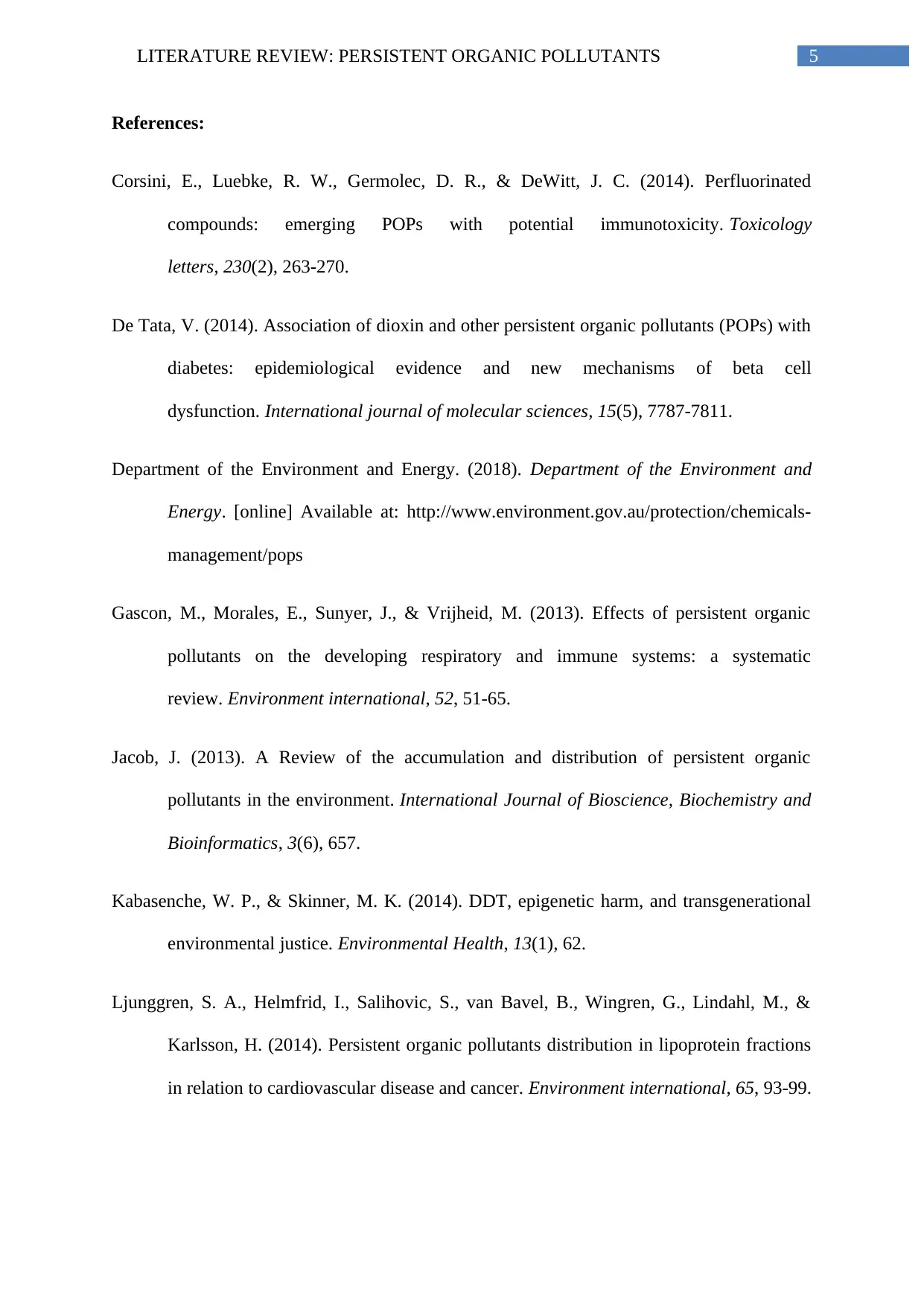
5LITERATURE REVIEW: PERSISTENT ORGANIC POLLUTANTS
References:
Corsini, E., Luebke, R. W., Germolec, D. R., & DeWitt, J. C. (2014). Perfluorinated
compounds: emerging POPs with potential immunotoxicity. Toxicology
letters, 230(2), 263-270.
De Tata, V. (2014). Association of dioxin and other persistent organic pollutants (POPs) with
diabetes: epidemiological evidence and new mechanisms of beta cell
dysfunction. International journal of molecular sciences, 15(5), 7787-7811.
Department of the Environment and Energy. (2018). Department of the Environment and
Energy. [online] Available at: http://www.environment.gov.au/protection/chemicals-
management/pops
Gascon, M., Morales, E., Sunyer, J., & Vrijheid, M. (2013). Effects of persistent organic
pollutants on the developing respiratory and immune systems: a systematic
review. Environment international, 52, 51-65.
Jacob, J. (2013). A Review of the accumulation and distribution of persistent organic
pollutants in the environment. International Journal of Bioscience, Biochemistry and
Bioinformatics, 3(6), 657.
Kabasenche, W. P., & Skinner, M. K. (2014). DDT, epigenetic harm, and transgenerational
environmental justice. Environmental Health, 13(1), 62.
Ljunggren, S. A., Helmfrid, I., Salihovic, S., van Bavel, B., Wingren, G., Lindahl, M., &
Karlsson, H. (2014). Persistent organic pollutants distribution in lipoprotein fractions
in relation to cardiovascular disease and cancer. Environment international, 65, 93-99.
References:
Corsini, E., Luebke, R. W., Germolec, D. R., & DeWitt, J. C. (2014). Perfluorinated
compounds: emerging POPs with potential immunotoxicity. Toxicology
letters, 230(2), 263-270.
De Tata, V. (2014). Association of dioxin and other persistent organic pollutants (POPs) with
diabetes: epidemiological evidence and new mechanisms of beta cell
dysfunction. International journal of molecular sciences, 15(5), 7787-7811.
Department of the Environment and Energy. (2018). Department of the Environment and
Energy. [online] Available at: http://www.environment.gov.au/protection/chemicals-
management/pops
Gascon, M., Morales, E., Sunyer, J., & Vrijheid, M. (2013). Effects of persistent organic
pollutants on the developing respiratory and immune systems: a systematic
review. Environment international, 52, 51-65.
Jacob, J. (2013). A Review of the accumulation and distribution of persistent organic
pollutants in the environment. International Journal of Bioscience, Biochemistry and
Bioinformatics, 3(6), 657.
Kabasenche, W. P., & Skinner, M. K. (2014). DDT, epigenetic harm, and transgenerational
environmental justice. Environmental Health, 13(1), 62.
Ljunggren, S. A., Helmfrid, I., Salihovic, S., van Bavel, B., Wingren, G., Lindahl, M., &
Karlsson, H. (2014). Persistent organic pollutants distribution in lipoprotein fractions
in relation to cardiovascular disease and cancer. Environment international, 65, 93-99.
⊘ This is a preview!⊘
Do you want full access?
Subscribe today to unlock all pages.

Trusted by 1+ million students worldwide
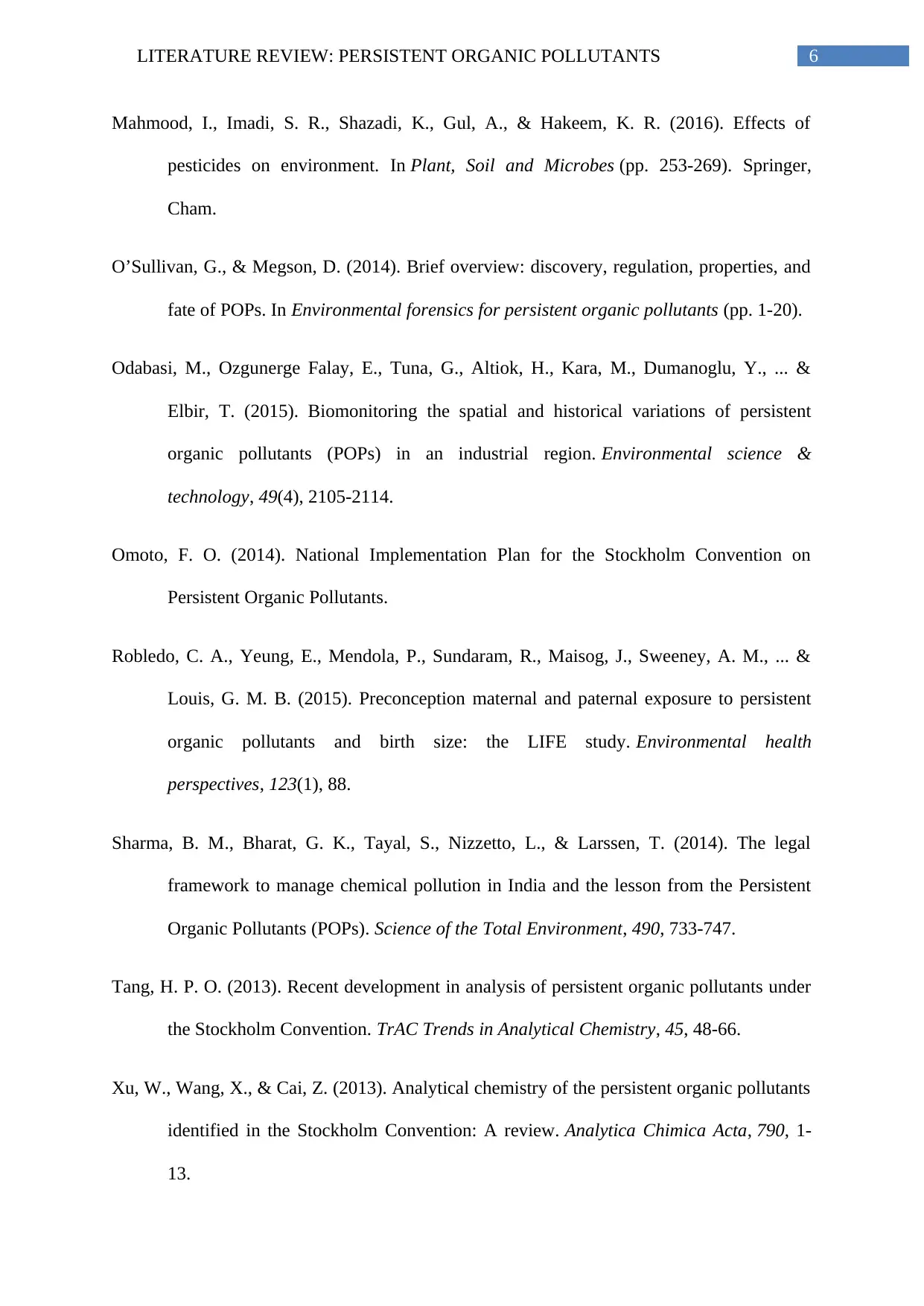
6LITERATURE REVIEW: PERSISTENT ORGANIC POLLUTANTS
Mahmood, I., Imadi, S. R., Shazadi, K., Gul, A., & Hakeem, K. R. (2016). Effects of
pesticides on environment. In Plant, Soil and Microbes (pp. 253-269). Springer,
Cham.
O’Sullivan, G., & Megson, D. (2014). Brief overview: discovery, regulation, properties, and
fate of POPs. In Environmental forensics for persistent organic pollutants (pp. 1-20).
Odabasi, M., Ozgunerge Falay, E., Tuna, G., Altiok, H., Kara, M., Dumanoglu, Y., ... &
Elbir, T. (2015). Biomonitoring the spatial and historical variations of persistent
organic pollutants (POPs) in an industrial region. Environmental science &
technology, 49(4), 2105-2114.
Omoto, F. O. (2014). National Implementation Plan for the Stockholm Convention on
Persistent Organic Pollutants.
Robledo, C. A., Yeung, E., Mendola, P., Sundaram, R., Maisog, J., Sweeney, A. M., ... &
Louis, G. M. B. (2015). Preconception maternal and paternal exposure to persistent
organic pollutants and birth size: the LIFE study. Environmental health
perspectives, 123(1), 88.
Sharma, B. M., Bharat, G. K., Tayal, S., Nizzetto, L., & Larssen, T. (2014). The legal
framework to manage chemical pollution in India and the lesson from the Persistent
Organic Pollutants (POPs). Science of the Total Environment, 490, 733-747.
Tang, H. P. O. (2013). Recent development in analysis of persistent organic pollutants under
the Stockholm Convention. TrAC Trends in Analytical Chemistry, 45, 48-66.
Xu, W., Wang, X., & Cai, Z. (2013). Analytical chemistry of the persistent organic pollutants
identified in the Stockholm Convention: A review. Analytica Chimica Acta, 790, 1-
13.
Mahmood, I., Imadi, S. R., Shazadi, K., Gul, A., & Hakeem, K. R. (2016). Effects of
pesticides on environment. In Plant, Soil and Microbes (pp. 253-269). Springer,
Cham.
O’Sullivan, G., & Megson, D. (2014). Brief overview: discovery, regulation, properties, and
fate of POPs. In Environmental forensics for persistent organic pollutants (pp. 1-20).
Odabasi, M., Ozgunerge Falay, E., Tuna, G., Altiok, H., Kara, M., Dumanoglu, Y., ... &
Elbir, T. (2015). Biomonitoring the spatial and historical variations of persistent
organic pollutants (POPs) in an industrial region. Environmental science &
technology, 49(4), 2105-2114.
Omoto, F. O. (2014). National Implementation Plan for the Stockholm Convention on
Persistent Organic Pollutants.
Robledo, C. A., Yeung, E., Mendola, P., Sundaram, R., Maisog, J., Sweeney, A. M., ... &
Louis, G. M. B. (2015). Preconception maternal and paternal exposure to persistent
organic pollutants and birth size: the LIFE study. Environmental health
perspectives, 123(1), 88.
Sharma, B. M., Bharat, G. K., Tayal, S., Nizzetto, L., & Larssen, T. (2014). The legal
framework to manage chemical pollution in India and the lesson from the Persistent
Organic Pollutants (POPs). Science of the Total Environment, 490, 733-747.
Tang, H. P. O. (2013). Recent development in analysis of persistent organic pollutants under
the Stockholm Convention. TrAC Trends in Analytical Chemistry, 45, 48-66.
Xu, W., Wang, X., & Cai, Z. (2013). Analytical chemistry of the persistent organic pollutants
identified in the Stockholm Convention: A review. Analytica Chimica Acta, 790, 1-
13.
1 out of 7
Related Documents
Your All-in-One AI-Powered Toolkit for Academic Success.
+13062052269
info@desklib.com
Available 24*7 on WhatsApp / Email
![[object Object]](/_next/static/media/star-bottom.7253800d.svg)
Unlock your academic potential
Copyright © 2020–2025 A2Z Services. All Rights Reserved. Developed and managed by ZUCOL.



